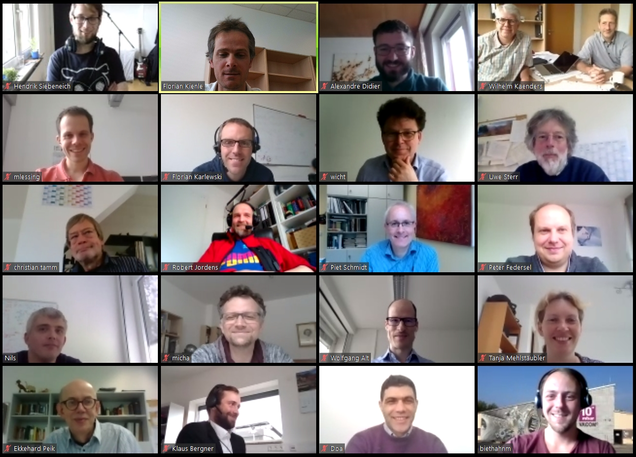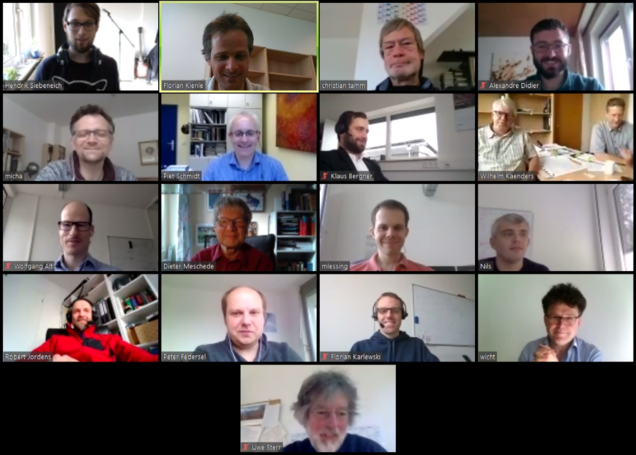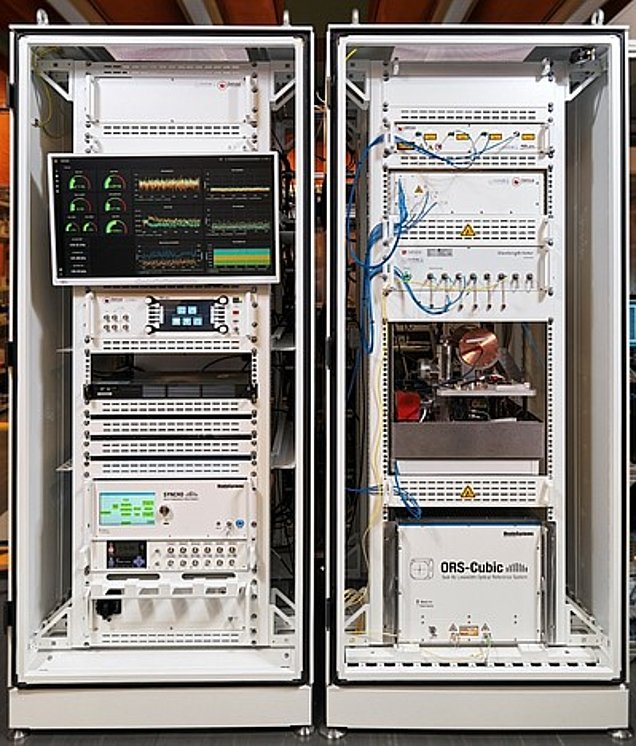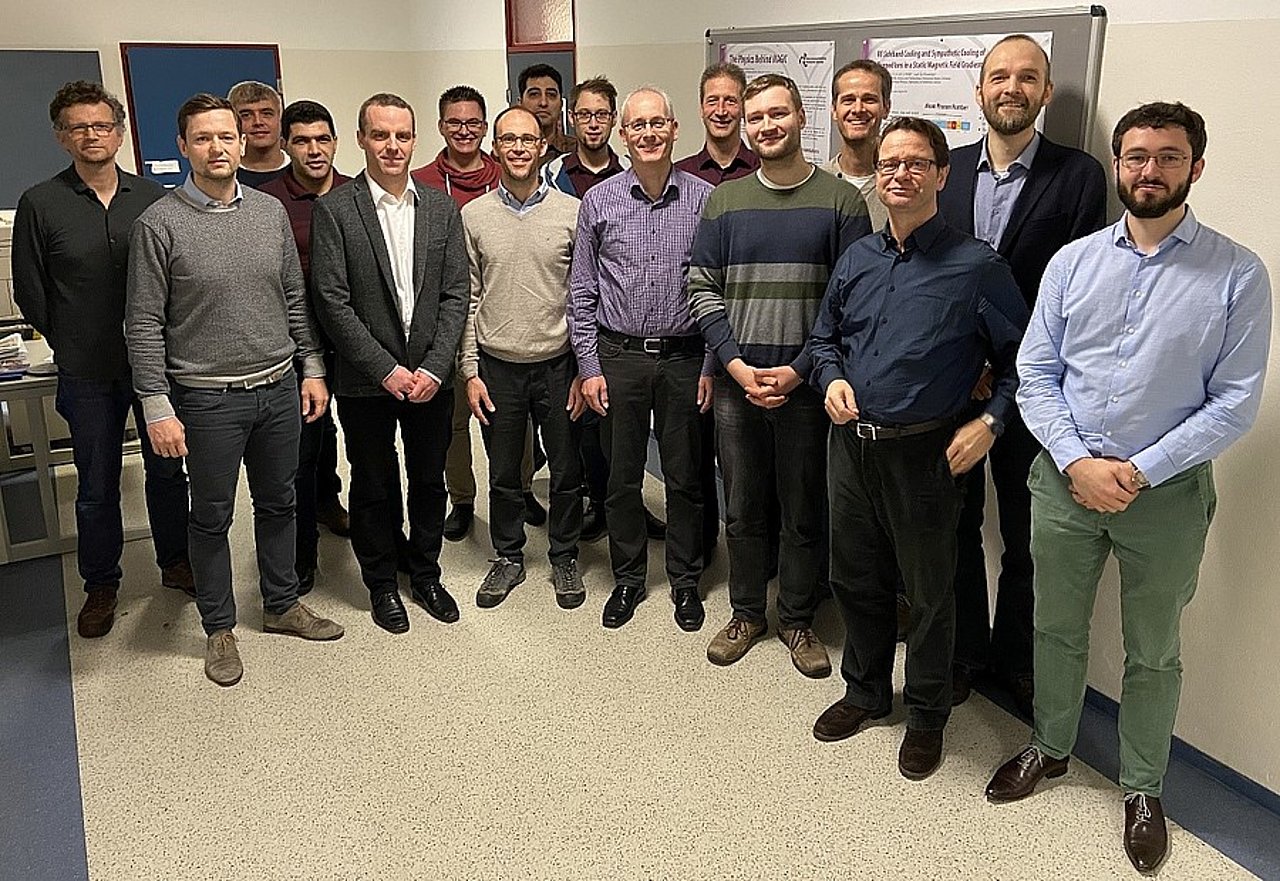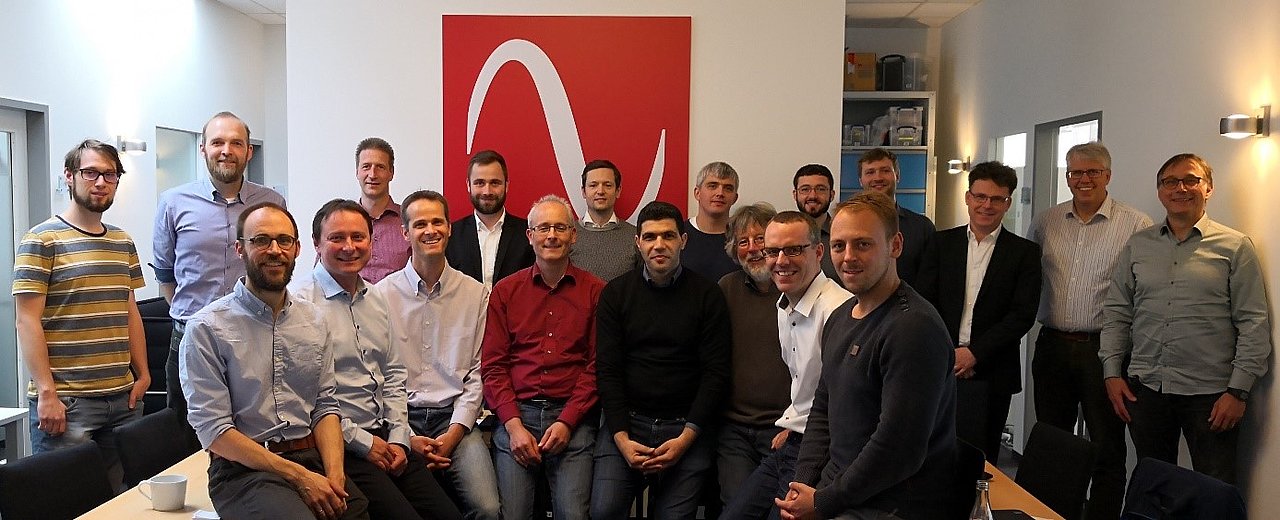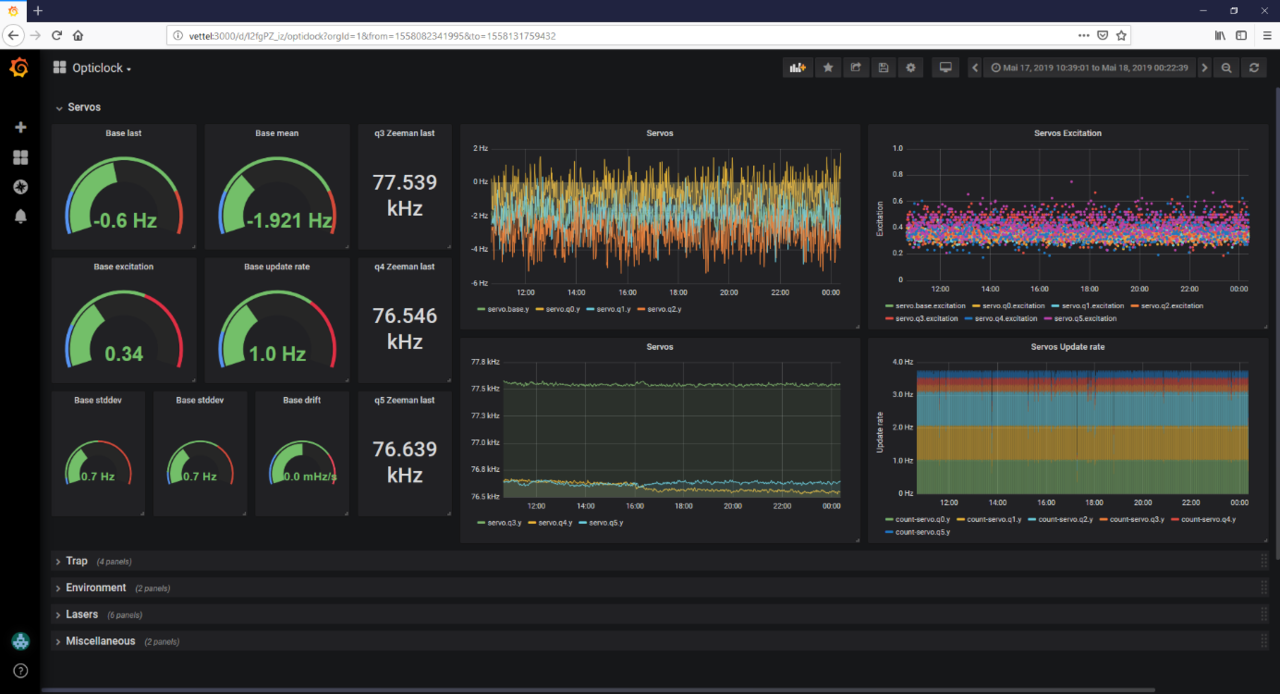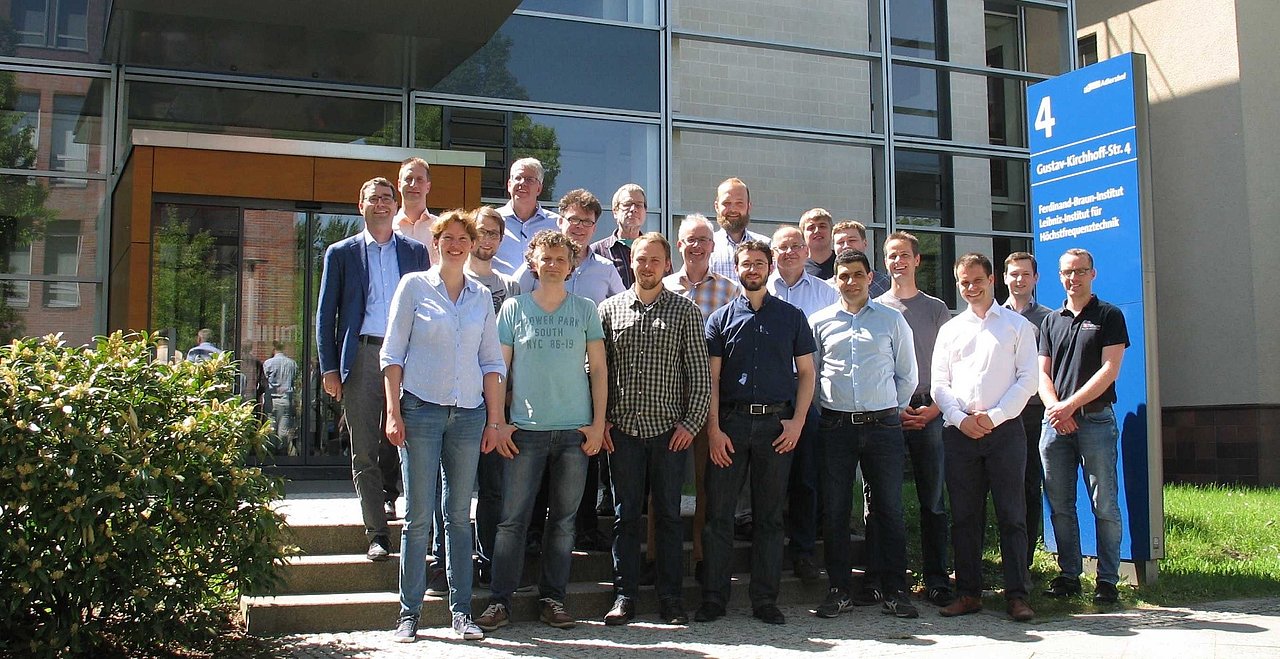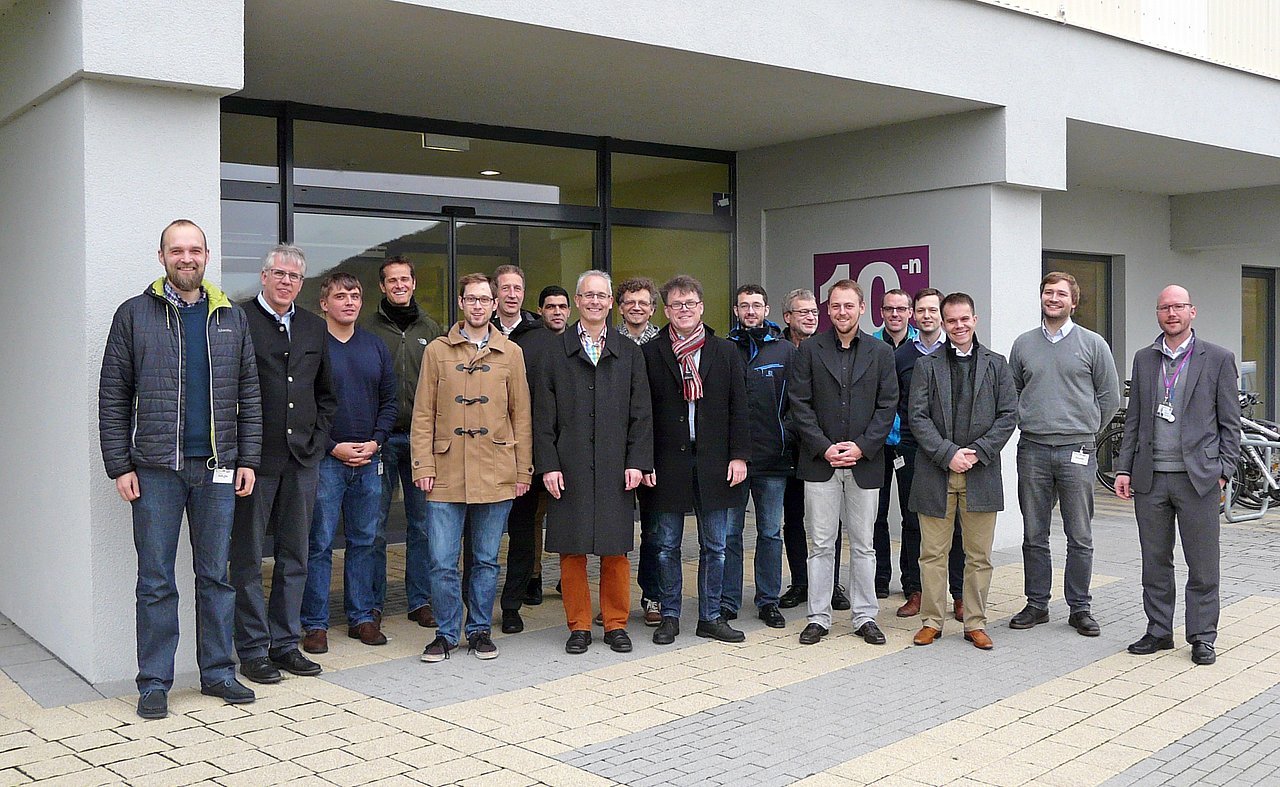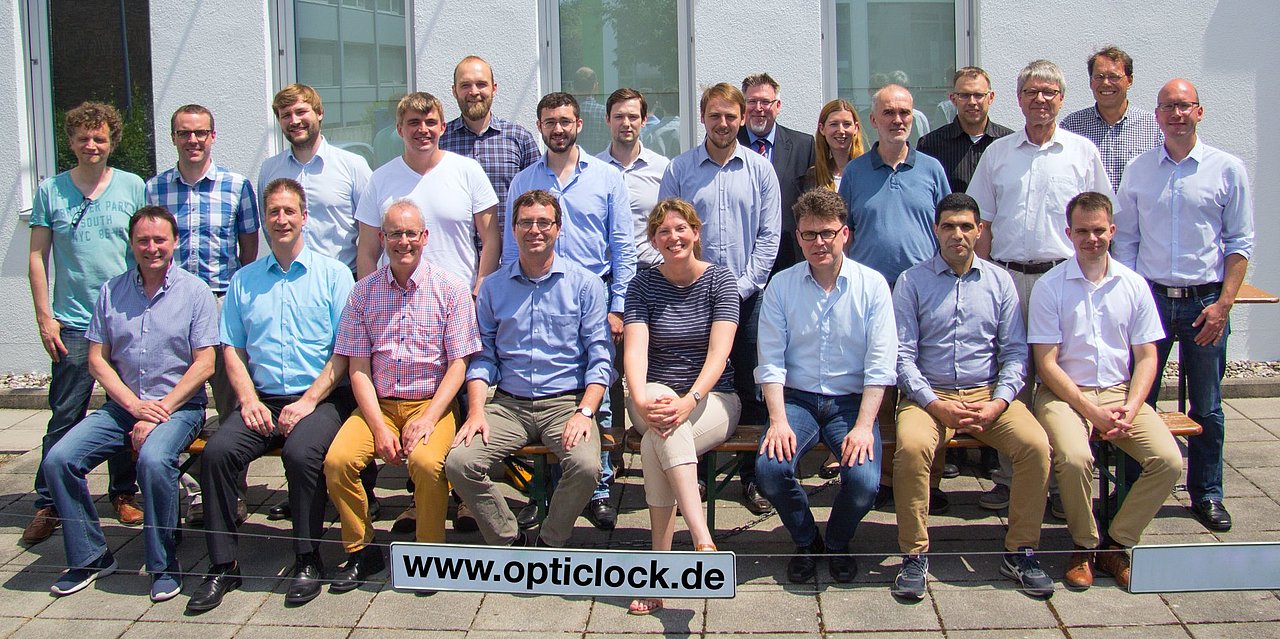Seventh opticlock meeting - all virtual
The 7th opticlock meeting was meant to be the concluding meeting to present all test results of the two developed devices (the clock demonstrator and the linear mulit-ion trap) and to put both into operation.
The corona virus crisis, however, stopped the team on the final few meters in front of the finish line. An extension of the project became unavoidable, which was readily granted by the funding body VDI. The new end date is now 31st of October 2020.
For the same reason, the half-day meeting on 30th of April 2020 was held in a virtual environment, with more than 20 participants in as many different locations.
Over the course of the past six months, the clock laser system was successfully integrated into the clock demonstrator racks. Thus, the final phase of characterization and evaluation started and is currently well underway. The clock specifications are carefully measured and a comparison against the PTB lab clocks is performed. The robustness and practicability is indicated by the already very high uptime of > 80% of its total runtime. Once bug-fixing and fine-tuning are finished and all crucial parameters are measured, a scientific publication will be written to accurately describe the outcome of this project.
The team working on the linear multi-ion trap achieved a breakthrough earlier this year by successfully trapping as string ions. In the following, it will continue with a careful tuning of the micromotion, an attempt to move ions from segment to segment and eventually a thorough characterization of the system.
The tasks that were compromised by the coronavirus impairments and are therefore still due, will commence immediately when normal working conditions at the different labs are possible again.
In the meantime, planning for the time after the project has begun. This includes various public relation activities as well as the first transport of the clock demonstrator and its use at the site of an interested end user.
Sixth opticlock meeting at Siegen University
On 27th and 28th of November 2019, the opticlock project team met at Siegen University to discuss progress on the project's milestones. Hosts were the project partners of Christof Wunderlich's group.
The opticlock demonstrator, i.e. the two transportable 19" racks, are now fully equipped with all sub-modules. The 871nm clock laser, which was the last sub-module to be integrated, is being fine-tuned and characterized at the moment as well as integrated into the central control software. Once these steps are completed, this clock laser will be connected to the so-called physics package that holds the vacuum apparatus and the ion trap. Normal clock operation in its ultimate configuration will then be started, followed by a thorough test and evaluation phase against other clocks (optical and Cäsium) of the PTB. Parallel to the described work, the team concentrated on the robustness, the user-friendliness and the autonomous operation of the other sub-modules.
Furthermore, the groups from Siegen University and the PTB have successfully assembled the novel linear trap system (not intended to be part of the demonstrator clock) and they are about to show a successfully trapped Ytterbium ion for the first time.
The project will end on April 30th 2020 after 3 years. We are confident to reach all project goals until then:
- Compactness: Two 19" racks, < 1000 kg, < 1 kW
- Accuracy: 10x better than Hydrogen mase
- High level of user-friendliness
- High degree of automation
- Fault recognition and fault recovery
- Operation in non-laboratory environments
- Simple transport and quick recommissioning
We are looking forward to soon putting opticlock into use and to presenting it to the public. First requests from interested groups reached us already.
Fifth opticlock meeting at HighFinesse
The opticlock team held its fifth general project meeting on 15th and 16th May 2019 at HighFinesse in Tübingen.
With representatives from the project sponsoring body BMBF/VDI present, the major milestone of being able to trap a 171Yb+ ion by using the developed modules was successfully demonstrated. Even more than that, a live performance of full clock operation was given via remote access to the opticlock system at the PTB. To this end, a PTB lab clock laser is temporarily connected to the opticlock physics package.
Development of the actual clock laser will be finalized this summer and it will hence be the final module to be integrated. Judging from current tests, the required frequency instability of < 1.5 x 10-15 (1 ... 100 s) appears to be achievable with this clock laser design.
The entire system is already operated by one central experiment control unit (HW and SW) offering services such as several clock automation features, logging of all accessible system parameters into a central database, and a graphical representation of input and output parameters in an intuitive and configurable GUI-cockpit.
From the mentioned preliminary clock operation tests and the resulting uncertainty budget, we estimate that a long-term instability of < 10-17 will be realistic and thus exceeding the original goal of being 10 times more stable than hydrogen masers.
The project is continuously presented at various conference, trade shows, meetings or seminars. One of which is the upcoming LASER World of Photonics trade show in Munich, for which a video clip was produced that introduces laser applications including quantum technologies, in particular the advantages of optical clocks and the transportable opticlock (available at https://videos.messe-muenchen.de/de/detail/4S9drwfis_Zxo8c2uR6pnm).
Fourth meeting of "opticlock" project team
The opticlock team met on 26th and 27th of November 2018 at Menlo Systems GmbH in Munich for its 4th project meeting. This meeting therefore took place at half-time of the 3-year long project.
The pre-assembled racks, with all HighFinesse and TOPTICA instruments built-in, were transported as planned to the PTB for further integration works just prior to the meeting. Three more main components will now be integrated and put into operation:
- The physics package (ion trap, vacuum apparatus, imaging optics) until May 2019, immediately followed by
- the clock laser (reference cavity, 871nm diode laser module) in summer/autumn 2019, while
- the central control electronics package (SW, HW) is being implemented in parallel.
Through photographs from the lab activities on the submodules as well as numerous data of the characterization measurements, it became clear at the meeting that the submodule development is well on track and already delivers very promising experimental results.
Third meeting of "opticlock" project team
On Monday and Tuesday, 7th and 8th of May 2018, the opticlock team met in sunny and warm Berlin for the third general meeting, hosted by the project partner Ferdinand Braun Institute. 21 participants attended the meeting.
During the meeting, exactly one year after commencing the project, each project partner presented their activities within the work packages from the past months. Most partners have now finished the design and concept phases, have been procuring components and materials, and started assembly of their individual opticlock sub-modules. Initial results from the sub-module characterization and evaluation were presented and discussed among the participants. The all-important mechanical, electrical and software interfaces were carefully aligned again, reacting on minor changes that emerged from this initial characterization phase. Whereas some work packages are already nearing their finish line, others pick up momentum insofar as sub-modules get interconnected and lifted to the next level of integration complexity. Here, a robust communication and flawless interplay will be the central aspects.
Furthermore, the team looked at the overall project time line, recollecting the upcoming milestones and handover dates to ensure that all development paths at the various sites will link up smoothly. In this regard, every partner had the opportunity to show in more detail its work package time lines to be challenged by the others.
In summary, the project is progressing very well and we are in good spirits that the major milestone "Yb+ ion successfully trapped" in May 2019 will be reached successfully, eventually leading to a successful opticlock demonstrator in May 2020.
QUTEGA pilot project "opticlock" - Consortium members gather for second project meeting
The opticlock project team met on 27th and 28th of November 2017 at Vacom GmbH near Jena, Germany, for its second project meeting after the kick-off in June. The goal of the opticlock project, which is one of only three QUTEGA pilot projects funded by the German Federal Ministry of Education and Research (BMBF) within the Photonics Research Germany program (FKZ 13N14380), is to transfer the highly complex optical clock technology, operated by specialists, out of the laboratory and into a more robust and compact, 19-inch rack-style, laymen-operatable demonstrator.
Representatives of all project partners presented their progress over the past six months, which were partially conceptual results, e.g. the system engineering and software communication concept of the two racks, but also first experimental results from optical and electronical sub-devices. A design review led to a common framework of specifications and requirements that were jointly agreed upon, so that the first major milestone was passed (critical design review).
The attendees from the project consortium of Ferdinand Braun Institute, HighFinesse GmbH, Menlo Systems GmbH, Physikalisch-Technische Bundesanstalt, QUARTIQ GmbH, Qubig GmbH, TOPTICA Photonics AG, University of Bonn, University of Siegen und Vacom GmbH took the opportunity for detailed discussions about general ideas, interesting technologies, upcoming experiments and development activities within their respective work packages.
The development of the Yb+ single-ion optical clock, tagged "opticlock", is advancing very well. We are confident that the clock will happily start ticking in summer 2020 to be employed as a practical tool for applications such as measurement of gravitational height differences in geodesy or synchronization of large networks (satellite navigation, computer systems, radio telescopes), all requiring a highly accurate frequency standard.



